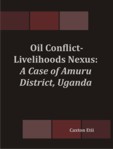Add abstract
Want to add your dissertation abstract to this database? It only takes a minute!
Search abstract
Search for abstracts by subject, author or institution
Want to add your dissertation abstract to this database? It only takes a minute!
Search for abstracts by subject, author or institution
Essays in Transportation Economics and Industrial Organization
by Kim Makuch
| Institution: | University of California – Irvine |
|---|---|
| Department: | |
| Degree: | |
| Year: | 2016 |
| Keywords: | Economics |
| Posted: | 2/5/2017 12:00:00 AM |
| Record ID: | 2126463 |
| Full text PDF: | http://www.escholarship.org/uc/item/7jp7p6kf |
This dissertation consists of three chapters: one chapter in industrial organization and two chapters in transportation economics. The first chapter studies competition between geographically differentiated firms selling differentiated products. Using an original data set of prices at a franchised retail coffee bar in New York City, this chapter examines how a retailer's price varies with its degree of geographic differentiation from competitors. The evidence shows that the relationship between price and geographic differentiation depends on the extent to which a product is differentiated from competitors' products in other characteristics. If products are otherwise sufficiently differentiated, prices are higher when competing retailers are located geographically close together. Products that are not sufficiently differentiated in other characteristics, by contrast, face lower prices when geographic differentiation is smaller. The findings appear to be consistent with multidimensional product differentiation models.The second and third chapters study driver behavior in congested traffic. The second chapter determines the size of the congestion externality generated by different vehicle types. Analysis of detailed vehicle trajectory data provides evidence that light trucks (pickups, sport utility vehicles, and vans) use 4-6% more road space than cars because drivers follow light trucks at a greater distance and light truck drivers follow other vehicles at a greater distance than car drivers. Using a bottleneck congestion model, I estimate that the average delay on a California freeway could be reduced by 26% or $2.2 million annually if all light trucks were replaced with cars. The third chapter explores the reliability of heuristics drivers may use to judge relative speed and make lane change decisions. Using vehicle trajectory data, I find that a driver may underestimate her speed relative to other lanes. She is also more likely to do so in heavily congested traffic. Given the external costs of lane changing and the evidence presented in this chapter, many lane changes are likely neither socially nor privately optimal.
Want to add your dissertation abstract to this database? It only takes a minute!
Search for abstracts by subject, author or institution


|
Oil Conflict-Livelihoods Nexus
A Case of Amuru District, Uganda
|

|
Testing Semi-Strong Form Efficiency and the PEAD A...
An Event Study based on Annual Earnings Announceme...
|

|
A Decomposition Analysis of Immigrants-Natives Wag...
Evidence from the Quarterly Labour Force Survey, 2...
|

|
Endogenous Origins of Economic Reforms in India an...
The Role of Attitudinal Changes: India (1980-1984)...
|

|
Development of a Forecasting Model to Predict the ...
|

|
China in Latin America
Political and Economic Implications of Beijing's I...
|

|
The Legitimacy of Economic Inequality
An Empirical Approach to the Case of Chile
|

|
An Empirical and Theoretical Analysis of Capital A...
|